Water Supply And Wastewater Engineering: Unit V: Sewage Treatment And Disposal
Activated Sludge Process and Extended Aeration Systems
Sewage Treatment and Disposal
It is an aerobic process. It has two treatment units - an Aeration Tank followed by a Secondary Settling Tank.
ACTIVATED
SLUDGE PROCESS AND EXTENDED AERATION SYSTEMS
•
It is an aerobic process. It has two treatment units - an Aeration Tank
followed by a Secondary Settling Tank.
•
The organic solids in sewage are stabilised by excessive production of
activated mass of aerobic microorganisms (called activated sludge).
•
The sewage after sedimentation in the primary sedimentation tank enters the
aeration tank where it is mixed with activated sludge (active microorganisms)
and aerated (oxygen supply) for long hours.
•
Aeration replenishes/increases dissolved oxygen (DO) level in sewage.
•
The microorganisms utilise the organic waste in sewage as food and multiply in
the presence of oxygen to synthesise numerous new microbial cells.
•
The increase in microbial biomass helps in decomposition of organic waste in
Ishotam I sewage.
•
Later the biomass is settled in the secondary settling tank. The settled sludge
has miw gnix active micro-organisms. (Activated Sludge)
•
Some portion of the sludge is recycled back to aeration tank in order to maintain
(high concentration of active microorganisms.
•
The mixture of waste water and activated sludge in the aeration tank is called Mixed Liquor.
Process Steps:
1.
Influent is either raw sewage or settled sewage from primary sedimentation
tank.
2.
Mixing of activated sludge with influent waste water to be treated (mixed
liquor) in aeration tank.
3.
Aeration and agitation of this mixed liquor in Aeration Tank for the required
length of time (4 to 8 hours).
4.
Multiplication of microbes by utilising organic waste in sewage and oxygen
(D.O).
5.
Settling/separation of activated sludge from the mixed liquor in the secondary
settling process.
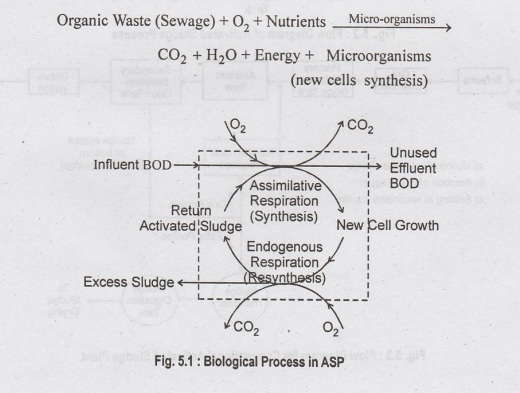
6.
Recycle proper amount of activated sludge back to aeration tank for mixing with
nistism on new b the new batch h of waste water (Sludge Recycling). to nothog
emo2
7.
Excess portion of sludge is disposed off after treatment. (Sludge Wasting)
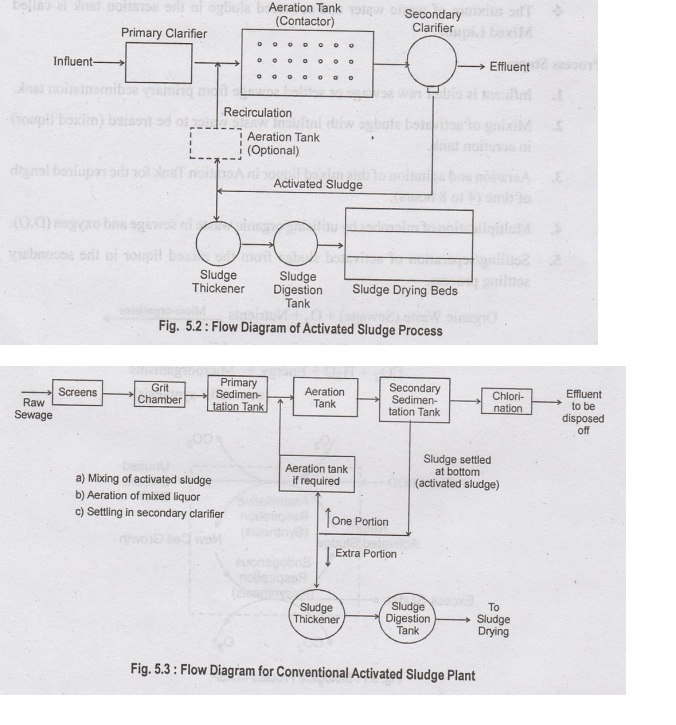
8. Efficiency Effluent obtained from activated sludge plant is clear and of high quality with BOD removal efficiency of 80-95% and bacteria removal efficiency of 90-95%.
9.
In ASP process, the following should be ensured:
(i)
Ample supply of oxygen.
(ii)
Intimate continuous mixing of sewage.
(iii)
Ratio of volume of activated sludge added to volume of sewage being treated kept
constant.
Operating Units of an ASP:
(i)
Screen Chamber + Grit Chamber + Primary Settling Tank. Removal of settleable
solids is helpful in preventing deposits on aeration devices.
(ii) Aeration Tank of ASP
[Continuous Aeration].
•
Normally rectangular tanks.
•
Depth 3 to 4.5 m.
•
Breadth 4 to 6 m.
•
Length 20 to 200 m.
•
Detention period 4 to 8 hours.
(iii) Secondary Settling Tank:
To remove or settle the activated sludge from mixed liquor.
Methods
of Aeration.
(i)
Diffused air aeration/Air diffusion.
(ii)
Mechanical aeration.
(iii)
Combined diffused air and mechanical aeration.
(i) Diffused
Aeration:
•
Compressed air under pressure of 35 to 70 kN/m2 is introduced to aeration
chamber through diffusion plates (Diffusers).
•
Diffusers fixed at the bottom of aeration tank diffuse air in small bubbles to
provide greater efficiency of aeration.
• Porous plates and porous tubes made of
quartz (or) crystalline alumina are used as diffusers.
•
Plates are square in shape with dimension of 30 cm x 30 cm and 25 mm thick.
bluora gniwollot
•
Tube diffusers are 60 cm long with internal diameter of 75 mm and thickness of wall
equal to 15 mm.
•
Types of Aeration Tanks → (i) Ridge and Furrow Type.
→
(ii) Spiral Flow Type.
•
In Ridge and Furrow Type, the tank is formed into a succession of ridges and
furrows and air is forced upwards through diffusers plates placed at the bottom
of the furrows.
•
In Spiral Flow type of aeration tank, air is introduced near the side of the
tank in such a way that spiral flow results in the tank.
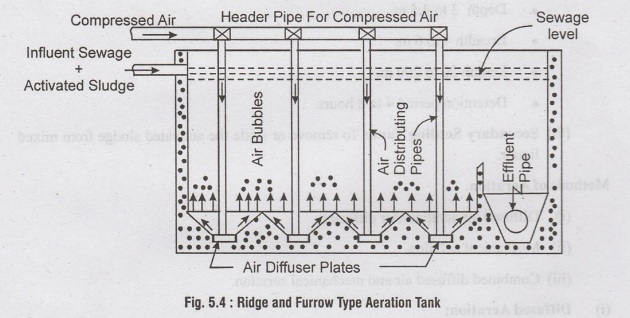
Air
required = 4000 to 8000 m3 of free air is required per million
litres of sewage being treated.
(or)
Air
required = 100 m3/day of air per kg of BOD removal.

Mechanical Aeration.
•
Atmospheric air is used (instead of compressed air).
•
Sewage is stirred up using mechanical devices like paddles (surface aerators).
•
Surface of sewage is continuously changed by circulation of sewage from bottom
to top and thereby introducing air from atmosphere into sewage.
•
Only requirement is thorough agitation.
•
Aeration period is 6 to 8 hours.
Types: (a) Haworth Paddle System:
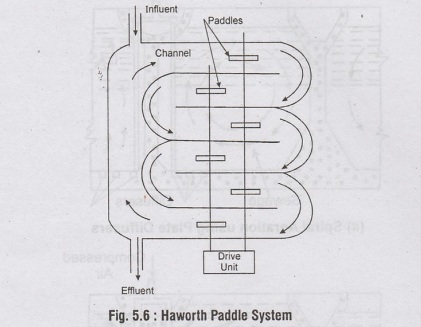
•
The aeration tank is divided into long narrow parallel channels.
•
Two paddles are provided between channel which rotates at 15 rpm and causes
spiral motion of sewage.
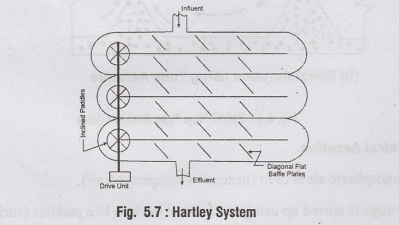
(b) Simplex System: (Bio-Aeration
System)
•
It is a square hopper bottom vertical flow tank.
•
At the centre, a hollow uptake draft tube is suspended from the top.
•
A steel cone with spiral vanes is provided at the top of the uptake tube and is
driven by motor.
•
The cone revolves at a speed of 60 r.p.m. which sucks the mixed liquor sewage
through the uptake tube by creating suction at the bottom and sprays it at the
top surface.
•
The spray then absorbs oxygen from the atmosphere.
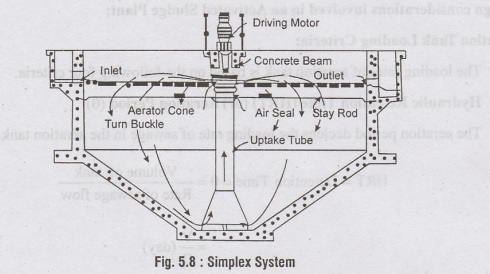
iii) Combined Aeration: (Dorr
Aerator)
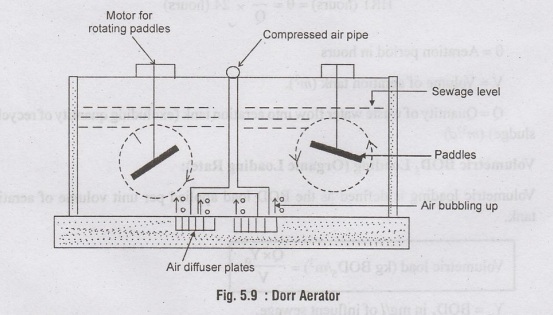
•
The diffused air aeration as well as the mechanical aeration are combined
together in a single unit.
•
A well known type is Dorr Aerator.
•
Aeration of sewage is achieved by diffusing air through bottom diffuser plates
as well as rotating paddles @ 10 to 12 r.p.m.
•
Very efficient system with detention period of 5 hours.
Design considerations
involved in an Activated Sludge Plant:
Aeration Tank Loading Criteria:
The
loading rates of aeration tank is based on the following four criteria.
(i) Hydraulic Retention Time (HRT)
(or) Aeration Period (θ):
The
aeration period decides the loading rate of sewage in the aeration tank.
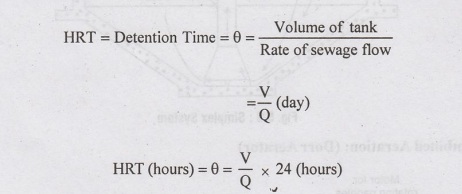
θ
= Aeration period in hours
V
= Volume of aeration tank (m3).
Q
= Quantity of waste water flow into aeration tank (excluding quantity of
recycled sludge) (m3/d)
(ii) Volumetric BOD5
Loading (Organic Loading Rate):
Volumetric
loading is defined as the BOD load applied per unit volume of aeration tank.

Yσ
=BOD, in mg/l of influent sewage.
V
= Aeration tank volume (m3).
Q
= Sewage flow in aeration tank (m3).
(iii) Food to Microorganisms (F/M
ratio)
robi
Food here means the organic waste (BOD) in sewage. When optimum F/M is reached
viz., sufficient food (organic waste) is available for the microorganisms, then
recycling of activated sludge has to be regulated by wasting (removing) excess
sludge from the system.
MLSS
-> Mixed liquor suspended solids.
Index
of mass of microbes in aeration tank.
MLSS
= Active Microbes + Dead Cells + Inert (Non-Biodegradable and Inorganic
Suspended Solids)
MLVSS
→ Mixed liquor volatile suspended solids
→
Mass of active microbes only

BOD
load applied to aeration system =
where
Yo. BOD5 of influent sewage (mg/l or g/m3)
Microbial
Mass = M = MLSS X V
=
Xt V
where
Xt is the microbial concentration (mg/l)
V
is the volume of tank.

F/M
ratio controls BOD removal.
Lower
F/M value, indicates higher BOD removal.
F/M
is varied by varying the MLSS microbial concentration.
iv)
Sludge Age/Solids Retention Time (SRT)/Mean Cell Residence Time (MCRT): θc
Average
time for which the mass of suspended solids (or biological solids) remain under
aeration.
HRT
→ Liquid (sewage) retention time in
aeration tank [3 to 30 hours].
MCRT
→ Biological Growth and Organic Solids are repeatedly recycled from secondary clarifier
to aeration tank. The solids retention time is MCRT and is expressed in days.
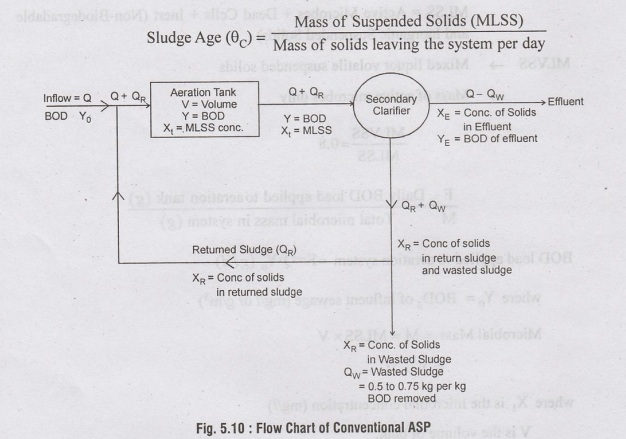
a) Mass of solids in reactor
M
= V x MLSS
=
V x X1
Xt
in mg/L.
b) Mass of solids removed with
wasted sludge per day
=
Qw × XR ………………(1)
c) Mass of solids removed with
effluent per day
=
(Q-Qw) XE ………………………(2)
d) Total solids removed per day

e) Sludge age

Xt
= Concentration of solids in influent of aeration tank (MLSS) is mg/l
V
= Volume of aerator.
Q
= Sewage inflow per day.
Qw
= Volume of wasted sludge per day.
QR
= Recycled sludge per day.
XR
= Concentration of solids in returned sludge (or) wasted sludge (mg/l).
XE
= Concentration of solids in effluent in mg/l.
If
XE value is small,

f) Recycle Ratio

g) Total Microbial mass in reactor
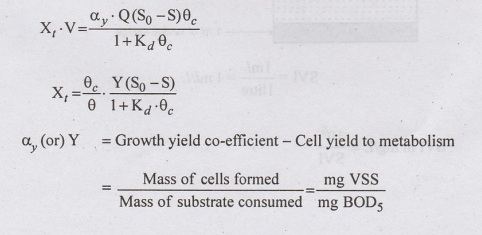
SO=
Influent Substrate Concentration/Influent Soluble BOD.
S
= Effluent Substrate Concentration/Effluent Soluble BOD.
θ
= Liquid Retention Time = V/Q = HRT.
Kd
=Micro-organism decay coefficient per day (d-1).
(v) Sludge Volume Index
(S.V.I)/Sludge Index
•
Indicates sludge concentration in system and settleability characteristics of
sludge.
•
Indicates the rate of sludge recycling required to maintain MLSS and F/M gm
ratio.
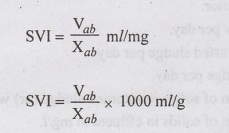
Xab
- Concentration of Suspended Solids in mixed liquor mg/l.
SVI
adopted = 50 to 150 ml/g = good settling sludge.
Lab Test for SVI
Volume
occupied by one gram of solids in mixed liquor after settling for 30 minutes is
measured.

(vi) Return Sludge Ratio:

Xt
= MLSS concentration mg/l
SVI
= Sludge Volume Index ml/g
Qr
= Recycled Sludge in MLD
Q
= Sewage Inflow in MLD
(vii) Oxygen requirement of
Aeration Tank.
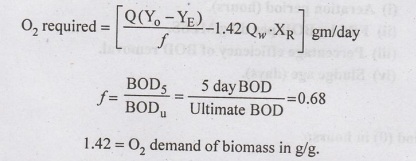
Assumptions for design of
conventional (plug flow) activated sludge plant
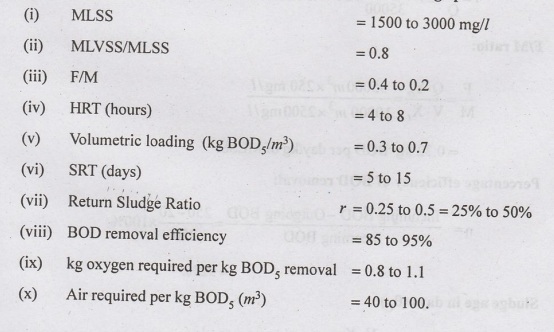
Water Supply And Wastewater Engineering: Unit V: Sewage Treatment And Disposal : Tag: : Sewage Treatment and Disposal - Activated Sludge Process and Extended Aeration Systems
Related Topics
Related Subjects
Water Supply and Wastewater Engineering
CE3303 3rd Semester Civil Dept 2021 Regulation | Tag: 3rd Semester Civil Dept 2021 Regulation
